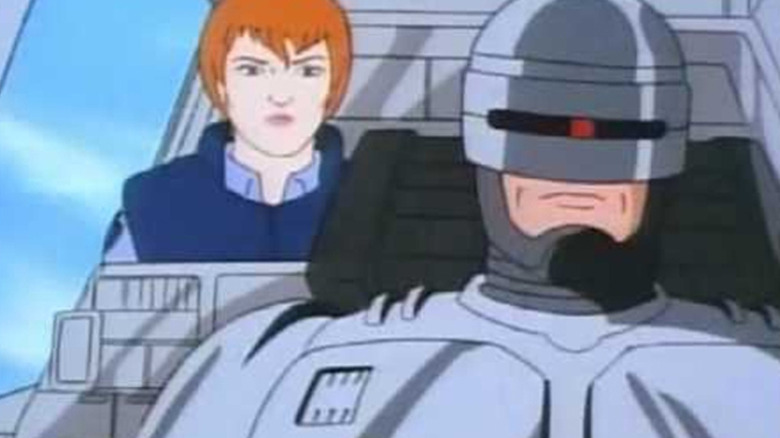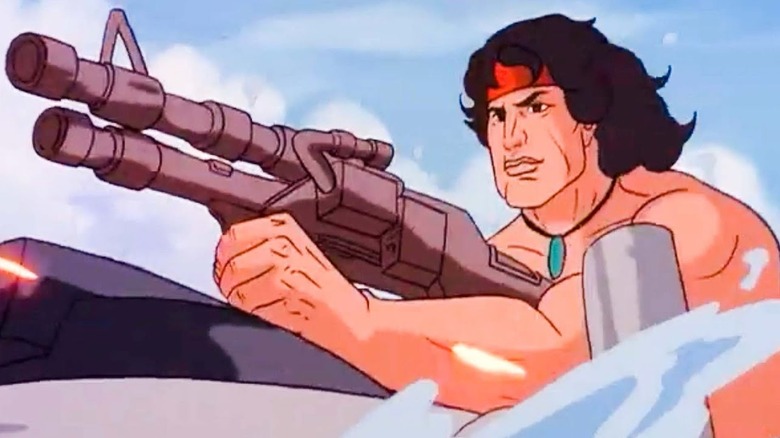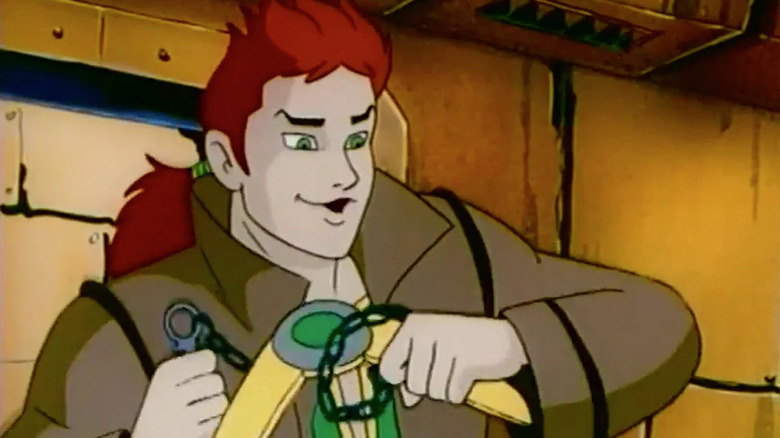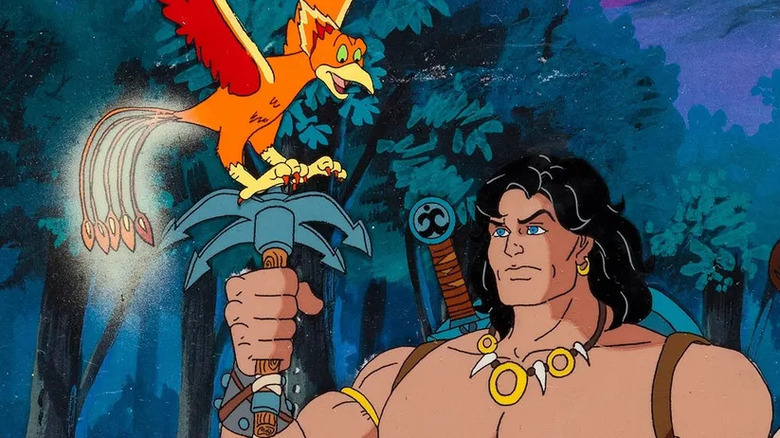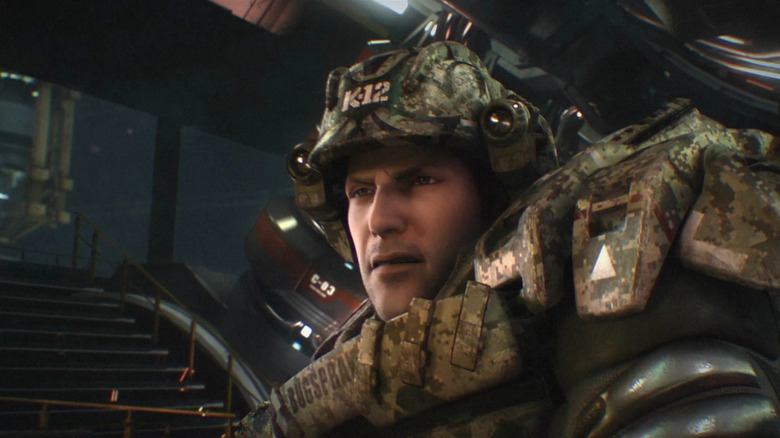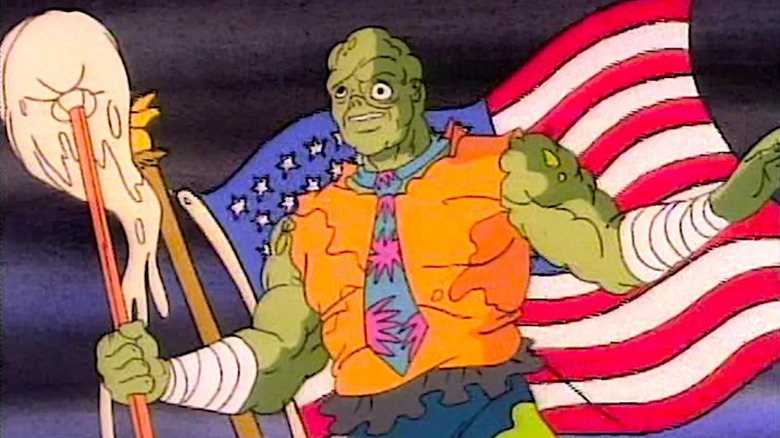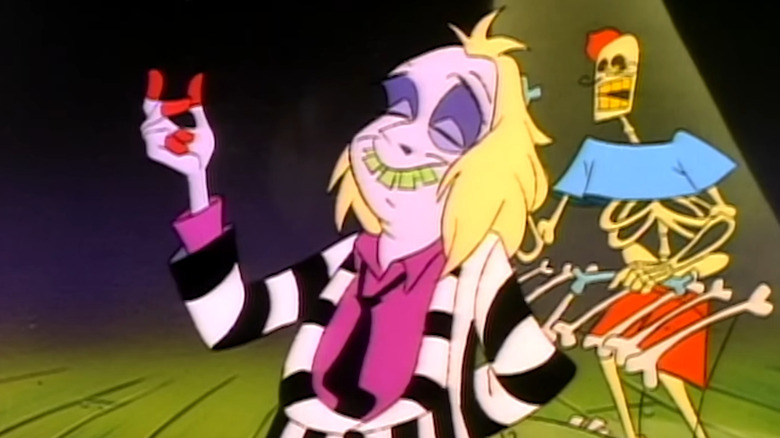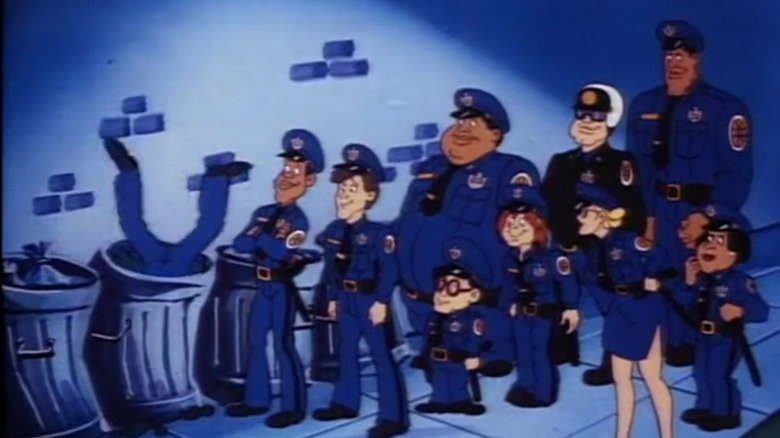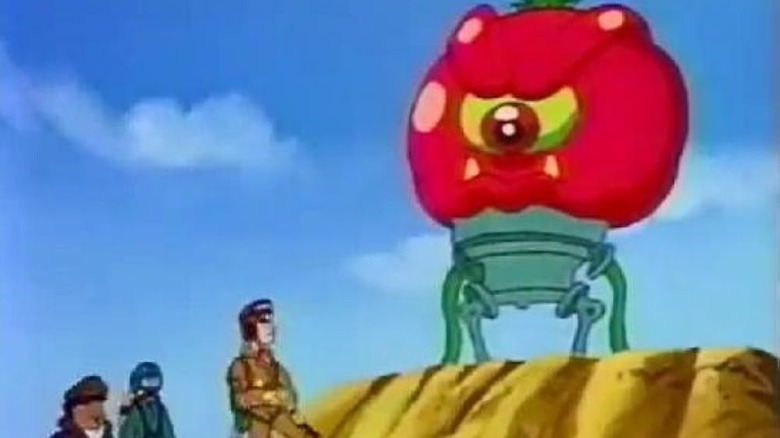10 Best Kids' Cartoons Based On Grown-Up Movies
We may receive a commission on purchases made from links.
R-rated movies started in 1968, creating a clear line of demarcation between movies kids could see, and movies they couldn't. Well, it's not that kids couldn't see R-rated movies: They just couldn't see them without being accompanied by an adult. So it wasn't an actual attempt to prevent the corruption of impressionable minds. Don't be silly. It was just the motion picture industry doing their darndest to pass the buck and avoid liability for showing kids things they had absolutely no business watching.
You can tell Hollywood wasn't too terribly concerned about kids being around R-rated, grown-up content given that the movie business made a mint selling toys, video games, comic books, and even cartoons about those same movies kids were prohibited from watching. There's no shortage of kid's cartoons based on R-rated movies, or at least movies primarily targeting grown-ups. No, some of these aren't as egregious as, say, "The Exorcist: The Animated Series" (as awesome as that would be), but looking at this list you'll think it's pretty crazy they made cartoons given how adult-skewing the movies were. Still, there's no denying these cartoons are pretty entertaining — almost as much as the movies they're based on.
RoboCop: The Animated Series
"RoboCop" has been featured in four films; two are R-rated and two are PG-13. (But the PG-13 ones are "RoboCop 3" and the 2014 "RoboCop" remake, so nobody of any age should watch them.) Most casual fans of the franchise believe only the first one is any good (make that really good). "RoboCop" punches far above its weight, promising an action-packed movie about a robot cop (which it delivers), while also providing a thought-provoking satire and inspirational hero's journey. Oh, it's also really, really violent. And there's sexual content. And drugs. Lots of drugs. Pretty much all of the above, usually in the same scene. But hey, if RoboCop is going to clean up the mean streets of 1980s Detroit, you have to showcase just how debaucherous the city had become.
But the core idea of a robot cop fighting crime was too good to pass up, so the adventures of Alex Murphy, Detroit Police Department, inspired not one, but two cartoons. "RoboCop: The Animated Series" released in 1988 from Marvel Productions (the studio behind the groundbreaking "X-Men: The Animated Series"), and pretty much picked up where the 1987 movie left off, just without the sex and drugs (but now with cartoony violence). "RoboCop: The Animated Series" lasted for just a single season with 12 episodes, but was followed by "RoboCop: Alpha Commando" in 1998, which toned the violence way down, as RoboCop was basically Inspector Gadget. Its silly shenanigans lasted for a single season and 40 episodes.
Rambo: The Force of Freedom
Nothing says "family friendly Saturday morning cartoon fun" quite like a special forces super soldier suffering from post-traumatic stress disorder after being taken as a prisoner of war in Vietnam, right? Yeah, okay then. "Rambo: The Force of Freedom" obviously didn't go as deep into Rambo's tortured psyche as the inaugural film, "First Blood." But heck, neither did any of the sequels either. Nope, the cartoon, like the movies, realized the character could easily be placed into any number of dumb, over-the-top action movie scenarios, which is essentially what "Rambo: The Force of Freedom" is about.
In the show, Rambo leads the titular "Force of Freedom" on missions around the world against General Warhawk and his terrorist organization S.A.V.A.G.E. (Specialist-Administrators of Vengeance, Anarchy, and Global Extortion). Is that "G.I. Joe"? Sure sounds like it. Welp, "G.I. Joe" meets "Rambo" sounds awesome, and indeed it was, for one season and 65 episodes in 1986. It's hard to overstate just how big a deal Rambo was in the mid-'80s, when the character was at the peak of his popularity. "Rambo: First Blood Part II" was the second highest-grossing domestic release of 1985 (behind "Back To The Future"), earning $300 million worldwide, or $900 million in today's dollars.
Highlander: The Animated Series
The "Highlander" franchise has never been a big hit; each of the five films in the franchise has bombed at the box office. Even the 1986 original only earned $12 million worldwide on a $16 million budget. Yet Hollywood keeps throwing buckets of money at this franchise that has never worked, with a reboot starring Henry Cavill coming soon (since he's not on "The Witcher" anymore).
All of which is to say, the "Highlander" brand just won't stay down, as producers continue to try to turn it into a viable brand. Enter "Highlander: The Animated Series," which successfully danced around the fact that the R-rated franchise was centered around decapitating people. And we gotta admit, it was pretty solid.
In a loose spin-off and sequel to the 1986 original film, "Highlander: The Animated Series" takes place in a post-apocalyptic future that resembles medieval Europe... but with killer cyborgs. OK, we're listening. In said future, Connor MacLeod's descendant Quentin must hone his skills and unite the Immortals to defeat the evil warlord Kortan — a quest he pursued for two seasons and 40 episodes between 1994 and 1996.
Conan The Adventurer
The "Conan the Cimmerian" series was created by Robert E. Howard, and was first introduced in a series of books starting in the early 1950s. Conan spread his wings (well, his biceps) and made his way into comic books in the '70s, but he didn't hit the big screen until 1982's "Conan the Barbarian," released nearly 30 years after the first book. Imagine a popular franchise taking 30 years to become a movie in this day and age. Unfathomable!
Anyway, the original R-rated "Conan the Barbarian" is best remembered as the movie that launched Arnold Schwarzenegger's career. Its $79 million worldwide box office ($265 million adjusted for inflation) on a $20 million budget meant a sequel was a no-brainer, though 1984's inexplicably PG-rated "Conan the Destroyer" showed the barbarian was a one-trick pony, making less than half the first film. Conan was dead as a movie franchise (for now), but was relaunched as the cartoon series "Conan the Adventurer" in 1992. Despite owing more to the PG-rated "Destroyer" that bombed than the R-rated "Barbarian" that thrived, "Conan the Adventurer" was fairly successful, running for two seasons and 65 episodes. Alas, given this was a kids cartoon, "Conan the Adventurer" was more safe than savage, resembling the "He-Man and the Masters of the Universe" series that had dominated the mid-'80s.
Roughnecks: Starship Trooper Chronicles
Dynamic Dutch director Paul Verhoeven developed a reputation for shocking violence, science fiction, and compelling satire in 1987's "RoboCop" and 1990's "Total Recall." After detours into erotic dramas like "Basic Instinct" and "Showgirls," Verhoeven returned to his cinematic comfort zone with 1997's "Starship Troopers."
Like pretty much all of Verhoeven's oeuvre, "Starship Troopers" is R-rated. Very, very R-rated. Besides human beings getting mutilated by the evil bug monsters, there's also profanity and nudity (such as the infamous shower scene with male and female soldiers bathing together). "Starship Troopers" is an awesome watch for those who like Verhoeven's schtick, but it's definitely not for kids. But hey, space soldiers killing bugs sounds pretty sweet, right? Kids would love that, yeah?
That's what the producers of "Roughnecks: Starship Trooper Chronicles" thought. And to be honest, the animated series is pretty solid, even if it obviously lacks the punch of the film (despite being executive-produced by Verhoeven). Using a 3D, computer-generated style, "Roughnecks: Starship Trooper Chronicles" follows the missions of a Mobile Infantry squad as they fight an infestation of evil alien insect invaders. The show bounced around networks throughout its one-season run of 40 episodes from 1999-2000. In the years since, "Roughnecks: Starship Troopers Chronicles" has built a cult following almost as passionate as fans of the film, and is way better than any of the series' straight-to-video sequels.
Toxic Crusaders
Starting with the 1984 original, the "Toxic Avenger" franchise has always been more of an esoteric series, with a small (make that very small) but devoted fanbase. Still, the existence of that avid audience was enough to get cartoon producers to try their hand at an animated series. It went, well, about as well as the movie series.
Loosely based on the movies, "Toxic Crusaders" follows the same premise of a nerd gaining super powers after getting bathed in toxic waste, and using his newfound abilities to fight evil environmental criminals. He forms a team of mutants, the titular "Toxic Crusaders," to battle the big bad guy, Dr. Killemoff (did his PhD advisors not think he may be an evil super-villain with that last name?) in the city of Tomaville. So basically, "Captain Planet" meets "Swamp Thing"? Like the films it was based on, "Toxic Crusaders" was not popular, lasting only 13 episodes. But that 13-episode run was still fun, and worth a watch for the few fans of this franchise.
Beetlejuice
Not every legacy sequel succeeds at the box office. For every "Top Gun: Maverick," there's a "Terminator: Dark Fate," "The Matrix Resurrections," or "Independence Day: Resurgence." To be honest, it doesn't matter how much money the original made at the box office, but how much fans fell in love with it in the subsequent years or even decades. Take "Beetlejuice Beetlejuice," which made more in its opening weekend than the original did in its entire worldwide run. Even adjusting for inflation, the 2024 sequel more than doubled the box office of the 1988 original. So clearly, there was pent-up demand for The Juice. The lion's share of that demand no doubt came from the love generations of fans have for Tim Burton and Michael Keaton's classic, quirky, macabre comedy. But we daresay at least some of that comes from millennial kids-turned-adults who became fans from the TV show.
"Beetlejuice" ran for four seasons and 95 episodes on ABC and Fox, more than almost any of the other animated series on this list, and by a pretty impressive margin. This is kind of bizarre when you consider the source material. No, "Beetlejuice" wasn't rated R, but it was about a dead couple navigating life in the underworld, haunting an eccentric family, and enlisting the aid of a devious demon. Doesn't exactly scream "kids TV," does it? Yet "Beetlejuice" was obviously a big hit, and helped create new fans of the franchise out of those tykes who may have been too young for the movie.
Police Academy: The Series
By last count, there are at least 300 "Police Academy" movies. OK, OK, that's a slight exaggeration. There's only seven, which may seem minuscule in a moviegoing universe dominated by multiverses, but "Police Academy" was out of control in the '80s. In fact, the first six "Police Academy" movies were released at a frequency of one movie per year between 1984 and 1989. The franchise took a five-year break, but was back with 1994's "Police Academy 7: Mission To Moscow," which earned a meager $126,000 and change. Yikes.
Only the original "Police Academy" was rated R, as producers realized the ridiculous, ribald humor was better suited for PG-13. And, eventually, for a cartoon series. Airing in syndication from 1988 to 1989, "Police Academy: The Animated Series" is unlike many of the other cartoons on this list, as it's not an adaptation based on the movies. Rather, it takes place chronologically within the series, specifically between "Police Academy 4: Citizens On Patrol" (1987) and "Police Academy 5: Assignment Miami Beach" (1988).
"Police Academy: The Series" was about a team of academy grads who are led by Carey Mahoney (Steve Guttenberg in the movies) through a series of misadventures. It lasted for two seasons and 65 episodes, proving you couldn't escape the franchise in the 1980s. While "Police Academy" was never exactly a critical darling, the cartoon does a good job bringing the movies to a new medium, as the franchise was basically a cartoon anyway.
Attack of the Killer Tomatoes
While not specifically R-rated, "Attack of the Killer Tomatoes" and its three sequels were mostly targeted to adults, specifically those old enough to remember the B-movies it was spoofing. Released in 1978, "Attack of the Killer Tomatoes" was a horror-comedy hybrid (a "homedy," if you will) about the world being attacked by a hungry horde of mutated, murderous tomatoes, and the group of scientists who team up to stop them. So basically, just like a bazillion B-movies from the 1950s, only with giant radioactive animals replaced by vegetables. It was a one-note joke out of which the filmmakers somehow managed to squeeze an hour-and-a-half-long movie, as well as three additional sequels. Clearly, the satirical series had its supporters, which is why it also launched a semi-successful kids cartoon show.
Running for two seasons and 20 episodes starting in 1990, "Attack of the Killer Tomatoes" came from Marvel Productions long before the MCU, and follows the same basic premise as the films. Though to keep the drama going for multiple episodes, the show follows a mad scientist named Dr. Putrid T. Gangreen (voiced by John Astin) who creates the monstrous mutant tomatoes, which also have the power to change into people. Like the film series it is based on, the Fox series certainly has its fans, and has cemented its status as a cult classic 35 years since its initial release. Spend a marathon watching this show, and you'll never look at your salad the same way again.
The Real Ghostbusters
Movies don't come much bigger than "Ghostbusters" in 1984, as it earned $295 million worldwide, or just over $900 million in today's dollars. Yep, an original comedy with sci-fi and horror elements nearly made the equivalent of a billion dollars. Sheesh, how much has the industry changed, right?
Anyway, the franchise has been riding that high ever since, trying to recapture the box office magic of the original. "Ghostbusters II" temporarily set the opening weekend box office record in 1989 (until Batman himself crushed it a week later). The series then spent decades in development hell, before the failed franchise reboot "Ghostbusters: Answer The Call" flopped in 2016, followed by legacy sequels "Ghostbusters: Afterlife" in 2021 and "Ghostbusters: Frozen Empire" in 2024. While these two films appear to have steadied the sinking ship, the series has topped out at around $200 million (sans inflation).
One bright spot for the franchise was "The Real Ghostbusters." The storyline is simple enough, as it follows the four heroes from the film as they fight specters and spirits around New York City. The only real difference is Slimer (a villain in the movie) is now the team's pet. Given some of the ribald humor, "Ghostbusters" was meant as a grown-up movie, but its massive success signaled there was a younger audience. "The Real Ghostbusters" clearly captured this fanbase, becoming the most successful cartoon series on this list by far, lasting seven seasons and 140 episodes from 1986 to 1991.

